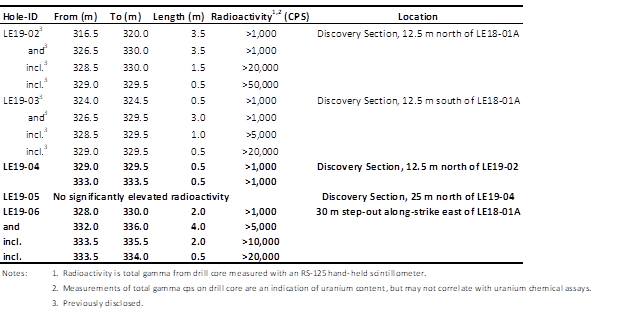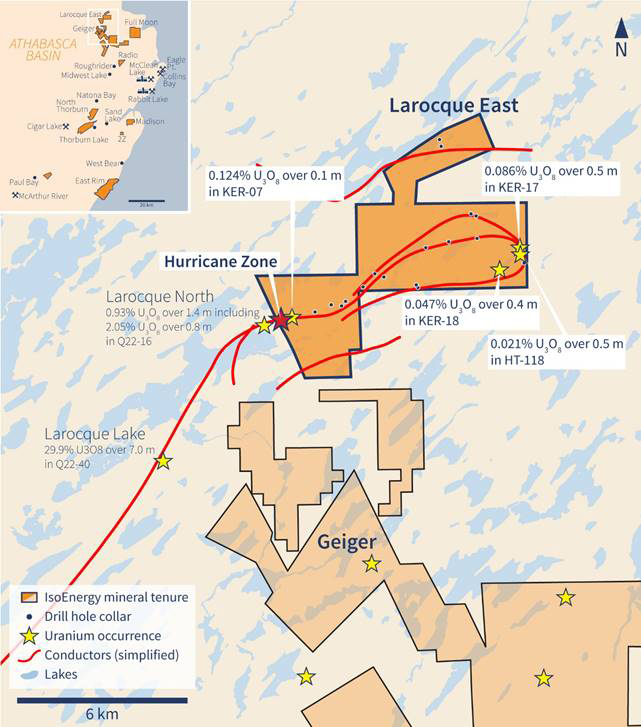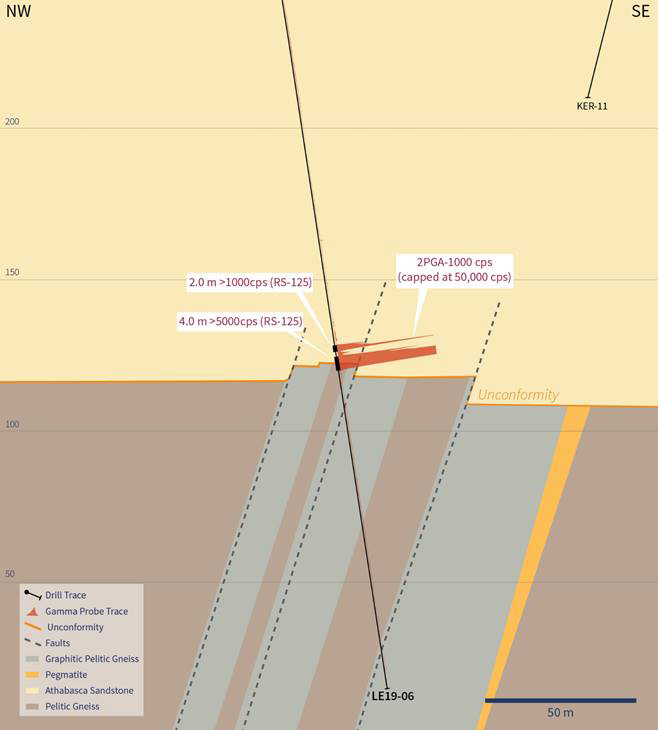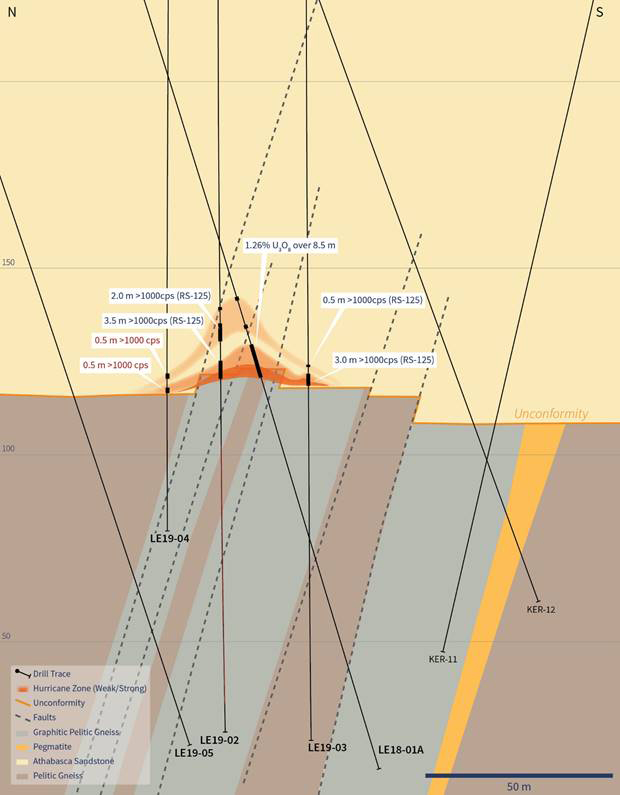IsoEnergy Intersects Strong Pitchblende Uranium Mineralization in First Along-Strike Step-out at the Hurricane Zone
February 11, 2019Vancouver, BC, February 11, 2019 – IsoEnergy Ltd. (“IsoEnergy” or the “Company”) (TSXV: ISO; OTCQX: ISENF) is pleased to announce that it has intersected an interval of strong (>20,000 total cps on an RS-125 hand-held spectrometer) uranium mineralization at the Hurricane zone in the first follow-up drill hole (LE19-06) completed along-strike of last summer’s intersection in drill hole LE18-01A. The Hurricane zone is a new discovery of high-grade uranium mineralization on the Company’s 100% owned Larocque East property in the eastern Athabasca Basin of northern Saskatchewan.
Drilling Highlights
- The first along-strike step-out from the discovery section has intersected strong pitchblende uranium mineralization in drill hole LE19-06
- Also, mineralization in drill hole LE19-04 extends the width of the Hurricane zone on the discovery section to at least 38 metres
- The company is fully funded for the current drill program and subsequent follow-up in 2019
Leigh Curyer, Chairman of the Board commented: “The founding of ISO to focus on exploring and securing properties in the eastern side of the Athabasca Basin has proven incredibly successful with Craig and his team targeting and intersecting high grade mineralization. The exploration methodology and disciplines developed in the NexGen / ISO group of which Craig has been a member since the incorporation of NexGen, are proving very effective in terms of targeting, intersecting and developing mineralization in a timely and cost-effective manner.”
Craig Parry, Chief Executive Officer commented: “The team has done a tremendous job in targeting and successfully finding high-grade mineralization at Hurricane. Based on my experience, I am very encouraged by these results given the extent of mineralization in only 6 holes to date. The 38 metre width of the zone on the discovery section is particularly impressive and initial radioactive intervals at Hurricane are certainly on par with other discoveries in the basin. The mineralization remains open in both directions along-strike and there is great potential for more good results from the ongoing program.”
Drill Hole LE19-06
Drill hole LE19-06 was designed to evaluate the potential for expansion of the Hurricane zone on section 4585E, along-strike to the east of discovery drill hole LE18-01A. The drill hole penetrated overburden and Athabasca sandstone to 336.0 metres and then basement metasedimentary gneiss to the end of the hole at 443 metres. Substantial uranium mineralization was intersected in the drill hole, 30 metres east of the mineralization in drill hole LE18-01A. The radioactive intervals (>1000 total cps on an RS-125 hand-held spectrometer) are summarized in Table 1 and are shown on a cross section in Figure 2. They include a 2.0-metre-long zone of uranium mineralization perched in the sandstone and centered about seven metres above the unconformity, and a 4.0-metre-long zone of stronger uranium mineralization that measures >5,000 cps (RS-125) and lies immediately above the sub-Athabasca unconformity. Mineralization is visually similar to the drill holes on the discovery section 4560E and includes fracture controlled, disseminated and replacement styles of pitchblende with hematite and clay. Within the lower interval is a 2.0-metre-long subinterval of stronger radioactivity that measures >10,000 cps on the RS-125. Within the 2.0-metre-long subinterval is a 0.5-metre-long zone of dark grey to black uranium mineralization that averages 28,000 cps (RS-125). Basement rocks immediately beneath the mineralization consist of bleached and clay-rich graphitic cordierite augen gneiss with several major fault zones.
Drill Holes LE19-04 and LE19-05
Drilled as an additional step-out on the discovery section 4560E, 12.5 metres north of previously disclosed follow-up drill hole LE19-02, drill hole LE19-04 was designed to evaluate the potential for continued expansion of the Hurricane zone to the north. The drill hole penetrated overburden and then Athabasca sandstone to 333.5 metres. Weak uranium mineralization was intersected in two narrow intervals at the unconformity that are summarized in Table 1 and shown on Figure 3. These results demonstrate that mineralization at the Hurricane zone has a minimum cross-strike width of 38 metres, extending from drill hole LE19-03 in the south to LE19-04 in the north.
Drill hole LE19-05 intersected the sub-Athabasca unconformity 25 metres to the north of drill hole LE19-04, also on the discovery section 4560E. Substantial alteration in the sandstone suggests that additional targets are present north of this drill hole, however no significant mineralization was intersected.
Table 1 – Hurricane Zone Radioactive Intervals

Larocque East
Larocque East consists of 6 mineral claims totaling 3,200 hectares and was purchased in May, 2018. The Property is owned 100% by IsoEnergy and is not encumbered by any royalties or other interests. Larocque East is immediately adjacent to the north end of IsoEnergy’s Geiger property and is 35 kilometres northwest of Orano Canada’s McClean Lake uranium mine and mill.
The Property covers a 15-kilometre-long northeast extension of the Larocque Lake conductor system; a trend of graphitic metasedimentary basement rocks that is associated with significant uranium mineralization in several occurrences to the southwest of the Larocque East property. The closest of these are the Larocque Lake and Larocque North zones, which are located 6.5 kilometres and 0.4 kilometres, respectively, to the southwest of the western Larocque East property boundary. Drilling at Cameco’s Larocque Lake zone has returned historical intersections of up to 29.9% U3O8 over 7.0 metres in drill hole Q22-040. Drilling at the Cameco’s Larocque North zone has returned intersections of up to 2.05% U3O8 over 0.6 metres in drill hole Q22-16. Like the nearby Geiger property, Larocque East is located adjacent to the Wollaston-Mudjatik transition zone - a major crustal suture related to most of the major uranium deposits in the eastern Athabasca Basin. Importantly, the sandstone cover is thin, ranging between 140 metres and 330 metres in previous drilling.
A total of 23 historical drill holes have been completed on the Property along approximately 22 kilometres of graphitic conductors. Five of the historical holes have intersected weak uranium mineralization on the Larocque East property to date, including drill holes KER-07 (0.12% U3O8 over 0.1 metre) and KER-11 (0.06% U3O8 over 0.5 metre) near the western property boundary, within the general vicinity of the Hurricane zone.
Next Steps
Additional drilling will be completed on the 4585E cross-section to the north and south of drill hole LE19-06. This will be followed by along-strike step-outs to the west of the discovery section. Geochemical results from the new drill holes reported herein are expected within six weeks. Drill hole LE19-06 is the fifth of a planned 10-hole program. Following a $5.5M financing that closed in December, 2018, the company is fully funded for the current drill program and subsequent follow-up in 2019.
Figure 1 – Larocque East Property Location Map

Figure 2 – Cross-Section 4585E

Figure 3 – Discovery Cross-Section 4560E

Qualified Person Statement
The scientific and technical information contained in this news release was prepared by Andy Carmichael, P.Geo., IsoEnergy’s Senior Geologist, who is a “qualified person” (as defined in National Instrument 43-101 – Standards of Disclosure for Mineral Projects). Mr. Carmichael has verified the data disclosed. This news release refers to properties other than those in which the Company has an interest. Mineralization on those other properties is not necessarily indicative of mineralization on the Company’s properties. An RS-125 hand-held spectrometer was used to verify that the radioactivity is due to uranium. As the drill holes reported herein are vertical or near-vertical, and the mineralization is interpreted to be horizontal, the true thickness is expected to be within 90% of the cored intervals.
About IsoEnergy
IsoEnergy is a well-funded uranium exploration and development company with a portfolio of prospective projects in the eastern Athabasca Basin in Saskatchewan, Canada and a historic inferred mineral resource estimate at the Mountain Lake uranium deposit in Nunavut. IsoEnergy is led by a Board and Management team with a track record of success in uranium exploration, development and operations. The Company was founded and is supported by the team at its major shareholder, NexGen Energy Ltd.
Craig Parry
Chief Executive Officer
IsoEnergy Ltd.
+1 778 379 3211
cparry@isoenergy.ca www.isoenergy.ca
Investor Relations
Kin Communications
+1 604 684 6730
iso@kincommunications.com
www.isoenergy.ca
Neither the TSX Venture Exchange nor its Regulations Services Provider (as that term is defined in the policies of the TSX Venture Exchange) accepts responsibility for the adequacy or accuracy of this release.
This news release shall not constitute an offer to sell or a solicitation of any offer to buy any securities, nor shall there be any sale of any securities in any jurisdiction in which such offer, solicitation or sale would be unlawful. The securities referenced herein have not been, nor will they be, registered under the United States Securities Act of 1933, as amended (the “U.S. Securities Act”), and such securities may not be offered or sold within the United States absent registration under the U.S. Securities Act or an applicable exemption from the registration requirements thereunder.
Forward-Looking Information
The information contained herein contains “forward-looking statements” within the meaning of the United States Private Securities Litigation Reform Act of 1995 and “forward-looking information” within the meaning of applicable Canadian securities legislation. “Forward-looking information” includes, but is not limited to, statements with respect to the activities, events or developments that the Company expects or anticipates will or may occur in the future, including, without limitation, planned exploration activities. Generally, but not always, forward-looking information and statements can be identified by the use of words such as “plans”, “expects”, “is expected”, “budget”, “scheduled”, “estimates”, “forecasts”, “intends”, “anticipates”, or “believes” or the negative connotation thereof or variations of such words and phrases or state that certain actions, events or results “may”, “could”, “would”, “might” or “will be taken”, “occur” or “be achieved” or the negative connotation thereof.
Such forward-looking information and statements are based on numerous assumptions, including among others, that the results of planned exploration activities are as anticipated, the price of uranium, the anticipated cost of planned exploration activities, that general business and economic conditions will not change in a material adverse manner, that financing will be available if and when needed and on reasonable terms, that third party contractors, equipment and supplies and governmental and other approvals required to conduct the Company’s planned exploration activities will be available on reasonable terms and in a timely manner. Although the assumptions made by the Company in providing forward-looking information or making forward-looking statements are considered reasonable by management at the time, there can be no assurance that such assumptions will prove to be accurate.
Forward-looking information and statements also involve known and unknown risks and uncertainties and other factors, which may cause actual events or results in future periods to differ materially from any projections of future events or results expressed or implied by such forward-looking information or statements, including, among others: negative operating cash flow and dependence on third party financing, uncertainty of additional financing, no known mineral reserves or resources, the limited operating history of the Company, the influence of a large shareholder, alternative sources of energy and uranium prices, aboriginal title and consultation issues, reliance on key management and other personnel, actual results of exploration activities being different than anticipated, changes in exploration programs based upon results, availability of third party contractors, availability of equipment and supplies, failure of equipment to operate as anticipated; accidents, effects of weather and other natural phenomena and other risks associated with the mineral exploration industry, environmental risks, changes in laws and regulations, community relations and delays in obtaining governmental or other approvals.
Although the Company has attempted to identify important factors that could cause actual results to differ materially from those contained in the forward-looking information or implied by forward-looking information, there may be other factors that cause results not to be as anticipated, estimated or intended. There can be no assurance that forward-looking information and statements will prove to be accurate, as actual results and future events could differ materially from those anticipated, estimated or intended. Accordingly, readers should not place undue reliance on forward-looking statements or information. The Company undertakes no obligation to update or reissue forward-looking information as a result of new information or events except as required by applicable securities laws
